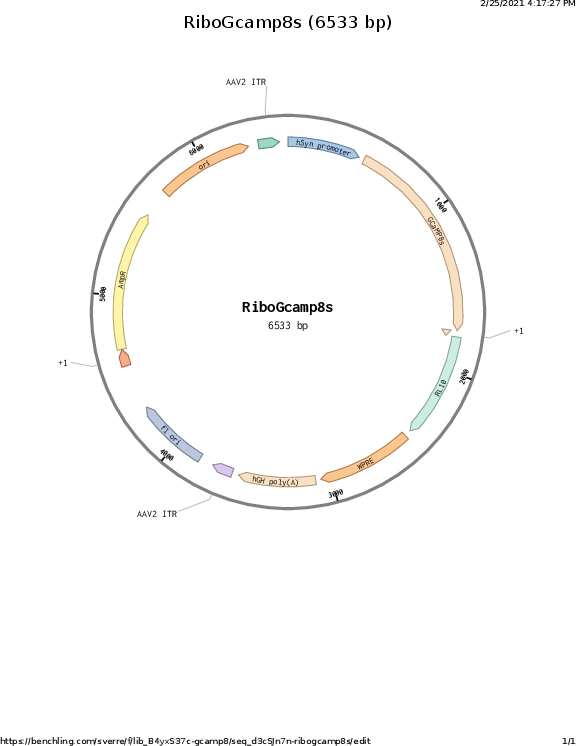AAV-hSyn-Ribo-jGCaMP8s
(Plasmid
#167572)
-
PurposePlease see Addgene item #169247 for an improved version of this plasmid. AAV transfer plasmid for neuronal expression of soma-targeted (RL-10, ribosomal tag) jGCaMP8s.
-
Depositing Lab
-
Sequence Information
Ordering
| Item | Catalog # | Description | Quantity | Price (USD) | |
|---|---|---|---|---|---|
| Plasmid | 167572 | Standard format: Plasmid sent in bacteria as agar stab | 1 | $85 | |
Backbone
-
Vector backbonepAAV
- Backbone size w/o insert (bp) 2868
- Total vector size (bp) 6533
-
Vector typeMammalian Expression, AAV
Growth in Bacteria
-
Bacterial Resistance(s)Ampicillin, 100 μg/mL
-
Growth Temperature37°C
-
Growth Strain(s)NEB Stable
-
Copy numberHigh Copy
Gene/Insert
-
Gene/Insert nameRibo-GCaMP8s
-
SpeciesM. musculus (mouse), R. norvegicus (rat), G. gallus (chicken); A. victoria (jellyfish)
-
Insert Size (bp)1956
- Promoter hSyn
-
Tag
/ Fusion Protein
- 6xHis (N terminal on insert)
Cloning Information
- Cloning method Restriction Enzyme
- 5′ cloning site BamHI (not destroyed)
- 3′ cloning site HpaI (not destroyed)
- 5′ sequencing primer TCGTGTCGTGCCTGAGAGCG
- 3′ sequencing primer cagcgtatccacatagcgtaaa (Common Sequencing Primers)
Resource Information
-
Supplemental Documents
-
A portion of this plasmid was derived from a plasmid made byRibo tag from #58777 and GCaMP8s from #162374.
Terms and Licenses
-
Academic/Nonprofit Terms
-
Industry Terms
- Not Available to Industry
Trademarks:
- Zeocin® is an InvivoGen trademark.
These plasmids were created by your colleagues. Please acknowledge the Principal Investigator, cite the article in which the plasmids were described, and include Addgene in the Materials and Methods of your future publications.
-
For your Materials & Methods section:
AAV-hSyn-Ribo-jGCaMP8s was a gift from Marianne Fyhn (Addgene plasmid # 167572 ; http://n2t.net/addgene:167572 ; RRID:Addgene_167572) -
For your References section:
An updated suite of viral vectors for in vivo calcium imaging using intracerebral and retro-orbital injections in male mice. Grodem S, Nymoen I, Vatne GH, Rogge FS, Bjornsdottir V, Lensjo KK, Fyhn M. Nat Commun. 2023 Feb 4;14(1):608. doi: 10.1038/s41467-023-36324-3. 10.1038/s41467-023-36324-3 PubMed 36739289






